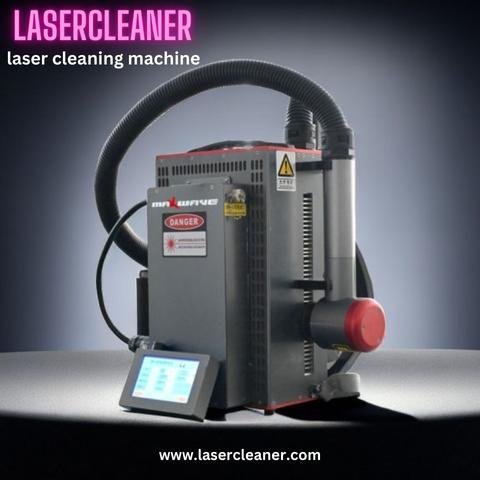What Is a Laser Cleaning Machine?
A laser cleaning machine is an advanced non-contact device that uses high-energy laser beams to remove contaminants, rust, paint, oxides, or coatings from the surface of materials. It's increasingly becoming the go-to solution across automotive, aerospace, electronics, construction, and manufacturing sectors due to its precision, eco-friendliness, and cost-efficiency.
Unlike traditional methods such as sandblasting or chemical cleaning, laser technology offers a dry, residue-free, and highly targeted process that doesn’t damage the substrate. This makes it ideal for sensitive or high-value surfaces.
Key Benefits of Laser Cleaning Machines
| Feature | Benefit |
|---|---|
| Non-contact process | No surface abrasion or secondary damage |
| Eco-friendly | No solvents, chemicals, or media used |
| Precision targeting | Ideal for micro-cleaning and complex geometries |
| Low maintenance | Minimal moving parts and consumables |
| Automation-friendly | Easily integrates with robotic systems |
Why Industries Are Switching to Laser Cleaning Machines
-
Reduced Operational Costs: No need for consumables like abrasive materials or solvents.
-
Improved Worker Safety: Eliminates exposure to hazardous chemicals and airborne particles.
-
Higher Throughput: Faster and repeatable cleaning cycles boost productivity.
-
Cleanroom-Compatible: Essential for industries like semiconductor manufacturing.
Types of Laser Cleaning Machines
There are various models and specifications depending on your cleaning requirements:
| Type | Best For | Power Range |
|---|---|---|
| Handheld Laser Cleaners | Spot cleaning, on-site work | 50W to 2000W |
| Robotic-integrated Systems | Mass production, automated lines | 1000W+ |
| Pulse Laser Cleaners | Delicate surface treatments | 20W to 100W |
| Continuous Wave Laser Machines | Heavy-duty rust or paint removal | 1000W+ |
How Does a Laser Cleaner Work?
-
Emission of Laser Pulses: A fiber laser generates pulses of energy.
-
Targeted Heating: The surface absorbs the beam, vaporizing or fracturing the contamination.
-
Debris Ejection: The material is removed instantly, leaving a clean, smooth substrate.
-
No Thermal Stress: Properly tuned lasers ensure no heat damage to the base material.
Applications of Laser Cleaning Machine Technology
-
Rust Removal: From ship hulls, pipelines, and old machinery
-
Paint Stripping: Aerospace components and automotive frames
-
Weld Preparation: Removes oil, oxides, and residues before welding
-
Cultural Heritage Conservation: Safe cleaning of statues, monuments, and relics
-
Mold Cleaning: In rubber and plastic injection molding
Advantages Over Traditional Cleaning Methods
| Aspect | Laser Cleaning | Sandblasting | Chemical Cleaning |
|---|---|---|---|
| Surface Damage | No | Moderate | High |
| Waste Generation | Minimal | High | High |
| Worker Safety | High | Low | Low |
| Precision | High | Low | Moderate |
| Environmental Impact | Low | High | High |
Expert Insights: What to Look for in a Laser Cleaning Machine
When choosing the right laser cleaner, consider:
-
Wattage: Higher wattage means faster cleaning, but may not be suitable for sensitive materials.
-
Portability: Handheld units are best for maintenance crews or on-site applications.
-
Cooling System: Air-cooled systems are lighter, while water-cooled systems are more effective for continuous use.
-
Pulse Duration: Shorter pulses offer greater precision.
-
Scan Width: Larger scan heads reduce cleaning time on wider surfaces.
Frequently Asked Questions (FAQs)
Is laser cleaning safe for all materials?
Laser cleaning is safe for most metals and hard surfaces. However, materials with low melting points or certain polymers may require specialized settings.
How long do laser cleaning machines last?
High-quality systems often last over 50,000 hours of operation, provided they’re maintained according to manufacturer recommendations.
Can laser cleaners be used outdoors?
Yes. Many handheld laser cleaning machines are rugged and designed for industrial or field use, making them effective for outdoor equipment, structures, or vehicles.
What power level should I choose?
-
20W–100W: Precision work (electronics, micro components)
-
200W–500W: General surface cleaning (tools, machinery)
-
1000W+: Heavy-duty industrial cleaning (rust removal, paint stripping)
Does laser cleaning require training?
Minimal training is needed due to the user-friendly interface, but for high-powered systems, operator certification is recommended for safety and optimal use.
Industry Trends and Insights
-
The global laser cleaning market is projected to grow at 7–10% CAGR, driven by automation and sustainability trends.
-
Fiber laser technology is now the dominant format, outperforming CO₂ and Nd:YAG in energy efficiency and longevity.
-
Increasing demand from EV battery manufacturing and aerospace for non-abrasive cleaning solutions.
Final Thought
As businesses seek cleaner, smarter, and faster ways to maintain assets and streamline production, the laser cleaning machine has emerged as an invaluable tool for the future of industry. Whether you’re managing aging infrastructure, prepping materials for fabrication, or restoring delicate artwork, laser technology offers unmatched control, speed, and environmental responsibility.

